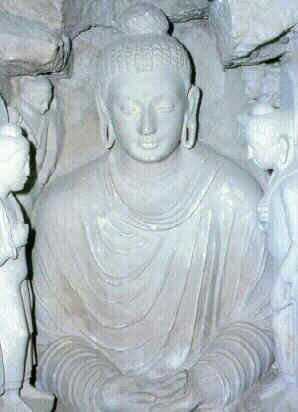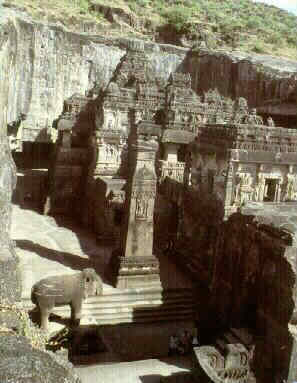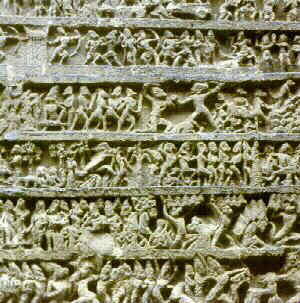


 |
 |
 |
 This Buddha of the Indo-Hellenic style has a purity of line and form. The blending of styles came to be known as the Gandhara school which was established at the intellectual and cultural centre of "Taxashila" around 500 B.C.  The Ellora Caves were created between AD 350 to 1000 by Buddhists, Hindus and Jains who laboured in turn to sculpt temples from the living rocks. Main attraction here is Hindu Temple of Lord of Kailasa. Over 200,000 tons of rock to a depth of 100 ft were removed with accuracy as once the rock was cut, it could not be replaced.  The Kailasa Temple wall releifs cover a stagerring area of just under 50,000 square yards at Ellora Caves. Many of the scenes from Ramayana and the temple structure is a representation of Shiva's Himalayan Home, Kailasa. |
Long before it was to be responsible for great works of art in Europe, religion in India had stirred the imagination of the people and formed artistic traditions that would permanently influence the development of art in the whole of south east Asia, China, Japan and Korea. Buddhism was the religion responsible for the renaissance. The 5th century BC was a remarkable one. It was an age of great intellectual tumult in almost every developed society of the time. Confucius in China, Zoroaster in Persia and Jeremiah in Israel were asking questions which would produce a revolution in man's view of life and the universe. In India a similar enquiry was tormenting a young Hindu prince by the name of Sidhartha. Buddhism would change the face of Asia. Meanwhile, there were further invasions of Indian soil and more foreign influences. In 520 BC, Darius of Persia annexed the Indus Valley and the Punjab. Persia held sway in these parts until another invader loomed large on the Indian horizon. In 326 BC, Alexander the Great, King of Macedonia, entered India, crushing both Persian and local forces, founding Greek settlements wherever he went. He didn't go very far, only halfway through the Punjab, and within two years he had turned his back on India, leaving behind a power vacuum and Greek influence. This power vacuum was soon filled by an imaginative young Hindu warrior-king, Chandragupta Maurya. Chandragupta ruled for a quarter of a century in great opulence and grandeur - a style which later Indian monarchs would emulate. He founded India's first unified empire, the Mauryan Empire (4th-3rd centuries BC). Under his grandson, Ashoka, it came to include most of modern India, Pakistan and parts of Afghanistan. For the first time, India became a single political unity. It was a time of peace and prosperity. Suddenly, highly polished monumental sculpture began to appear, the first stone sculptures since the Aryan invasion. At the same time the Buddhists began erecting their dome-shaped stupas. They were immense architectural feats - the somewhat later Sanchi stupa (lst century AD) is one of the masterpieces of Indian art and architecture. Buddhist monks began to cut temples in rock - a complex of these at Ajanta in western India became one of the glories of India's architecture, sculpture and painting. Emperor Ashoka, himself a convert to Buddhism, had columns of stone carved meticulously. He ordered Buddhist edicts to be inscribed on them and had them erected in all parts of his empire. His lion capital from Sarnath serves as the emblem of modern India. During his long and benign reign, Indian sculptors perfected their approach to stone. A tradition was created henceforth sculpture would be monumental. Within fifty years of Ashoka's death in 232 BC, the Mauryan Empire crumbled. More invaders came, waves of them. But only the Kushans from central Asia in the l st century AD managed to set up a durable kingdom. During the reign of Kanishka, their best-known king, a profound change took place in Buddhism which had far-reaching effects on Indian art. Until Kanishka's time, the Buddha has been regarded as the Great Teacher. But now, as a result of extraordinary religious debate, he came to be looked upon as the Supreme God. The effect upon art was dramatic. For the first time the figure of Buddha was carved as the Supreme God. -The Hindus, too, wanted to see their deities reproduced in stone and here the inexhaustible pantheon of Hindu gods and goddesses kept the sculptors of the Kushan school busy. To the traditional Mauryan roundness of form and monumental vigour they added an essentially Indian expression, giving to the sculpture of this period a truly Indian character. Mathura, near New Delhi, was the main centre of Kushan sculpture. Contemporary with this school was the Gandhara school on the present-day Pakistan-Afghanistan border. Here Alexander the Great's influence has resulted in Greco-Buddhist sculpture in the local grey-blue schist. The themes were Indian - Buddha and scenes from his life - the style Greek. The artists and their inspiration were Indian, the technique Greek; a memorable synthesis, a rewarding fusion. The Gupta Empire (4th - 6th centuries AD), generated a period of sustained magnificence in Indian art, a true cultural efflorescence. The Guptas believed they were the descendants of the Mauryas. They certainly had their flamboyance, imagination, verve and, what's more, they loved the carved and the adorned. During their empire Indian arts literature, sculpture, architecture and painting reached a creative pinnacle. Highly refined carving became the soul of sculpture, simplicity its hallmark. These elements, combined with the traditional monumentality, gave Gupta sculpture a distinct character - as seen at Mathura, Sarnath and the rock-cut caves of Ajanta and Ellora. The sculpture was no longer Buddhist nor Hindu - it was Indian sculpture, to be noted for its stunning simplicity and mood of calm achieved through inner tranquillity. For centuries to come, Indian sculptors would look back to the Gupta period for inspiration, strength and, what an artist values most, ideas. They would express divine power by calm grandeur at Elephanta and Mahabalipuram, and by dynamic movement in the Dancing Shiva at Ellora - the many arms of the god suggesting power. During the subsequent centuries, various parts of India developed their own styles, but none was more glorious than the bronze sculptures from the Chola School in south India during the 10th-12th centuries AD. The Chola artists fused the formal vigour, almost primitiveness, of their Dravidian roots with the poetic grace of the sculpture of, say, the Gupta period. They cast in bronze some of the greatest sculpture in the world. The Shiv Natarajs of this period, Shiva dancing the steps of creation-destruction, have a beauty which is both terrifying, mystical and moving. Superb examples of perfect esthetic balance, they give complete expression to what is most vital in representing motion through stillness in a statue - the rhythm of the charged movement, in this case, that of the creative and cosmic dance of God. |
 This intro to India page is being visualised/designed/maintained and updated by Mahendra.
This intro to India page is being visualised/designed/maintained and updated by Mahendra. 
